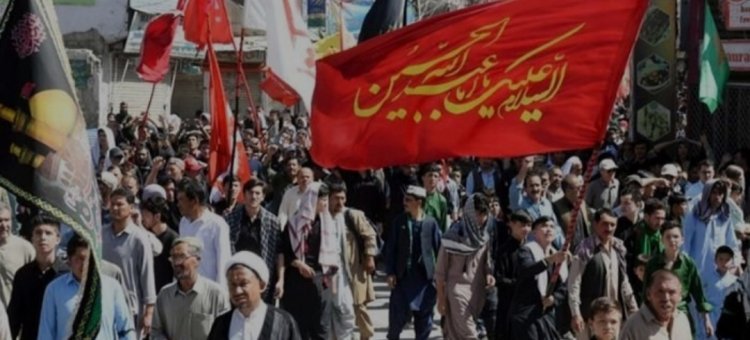An inspiration of Imam Hussain (AS) for Muslims to follow

Historians have credited Imam Hussain (AS) for creating an enduring revolution that eventually brought down Yazid and left an inspiration for Muslims to follow
As Imam Hussain (AS) held up his infant son, Ali Asghar (AS) before the army of Yazid seeking water for the malnourished and dehydrated baby, the instant response to his call was particularly cruel even by the standards of that day of unprecedented carnage.
Hurmula, an expert archer, raised his bow taking aim at the baby’s jugular and shot a three-pronged arrow, typically reserved in battle for horses. The martyrdom of Ali Asghar (AS) marked a glaring sacrifice by Imam Hussain (AS) before he rode in battle on the 10th day of Muharram (61st year of Hijra or October 10, 680 AD) to face Yazid’s army of anywhere between 30,000 and 70,000.
As Muslims across the world this week commemorate ‘Ashura’ – the day of the brutal martyrdom of Imam Hussain (AS) and his 72 followers almost 1400 years ago in Karbala, southern Iraq, graphic details such as the martyrdom of Ali Asghar (AS) continue to reinforce the remembrance from centuries gone by.
Other martyrs with reference to that tragic day included Ali Akbar (AS), the elder son of Imam Hussain (AS), the brothers of Imam Hussain notably Hazrat Abbas (AS) and his nephews Hazrat Qasim bin Hasan (AS), Hazrat Aun bin Abdullah (AS) and Hazrat Mohammad bin Abdullah (AS). Other martyrs included close companions of Imam Hussain (AS), notably Habib ibne Mazahir Al-Asadi, Zuhayr ibn Al-Qayn Al-Bajali and Hur ibne Yazid e Riyahi, a prominent military commander from Yazid’s army who defected to Imam Hussain on the morning of the battle.
The very continuation of the mourning over centuries owes as much to the monumental scale of the tragedy in the days leading up to the 10th of ‘Muharram’ and beyond, alongside conscious choices made by Imam Hussain (AS) to ensure its remembrance for all times to come.
Historical accounts refer to the decision by Imam Hussain (AS) two days before ‘Haj’ to abandon his planned annual pilgrimage to Mecca following reports of Yazid’s hired assassins already there to assassinate him. Instead he performed ‘Umrah’ [year round pilgrimage to Makkah] before heading to Iraq.
It was a conscious choice to leave Makkah, based on the principle of avoiding bloodshed and preserving the sanctity of the holy ‘Kaaba’ – located in the holiest of cities for Muslims. Though the sanctity of the ‘Kaaba’ has been violated in subsequent times, the choice by Imam Hussain (AS) nevertheless renewed a principle for all times to come.
And through the three-week journey from Makkah to Karbala, Imam Hussain (AS) stopped at 13 locations before arriving at his 14th and final destination – Karbala. During this journey, Imam Hussain (AS) consciously avoided mobilizing an army despite at least one account of a tribal leader offering 20,000 fighters to accompany him in battle.
Clearly, the mission of Imam Hussain (AS) was more of a passive resistance than an active military campaign. In a letter on his way to Karbala to his younger brother Muhammad al-Hanafiyya, Imam Hussain (AS) wrote: “I have not come out to stir emotions, to play with oppression… I want to lead them [Muslims] to the path of my grandfather and my father Ali Ibn Abi Talib”.
Historians have credited Imam Hussain (AS) for creating an enduring revolution that eventually brought down Yazid and left an inspiration for Muslims to follow. “The revolutionary spirit [of Islam] was present. However, it was diminished due to the paralyzed psyche that was prevalent in the people who desired change but were aware of the hopeless reality [in the face of an oppressive regime]” wrote Ayatollah Muhammad Mahdi Chamseddine, the widely respected Lebanese Islamic leader and a leading advocate of intra-Muslim unity.
Any detailed examination of the tragedy of Karbala will remain incomplete without remembering the fine example of Bibi Zainab (AS), the younger sister of Imam Hussain (AS), who led the victims of Karbala-women and children alongside one adult male –Imam Zainul Abideen (AS) – once the conflict was over. Her eloquent sermons in captivity, notably while facing Yazid have been widely acknowledged as a fine example of defiance in the face of adversity.
Writing in his widely noted book ‘The Victors of Imam Hussain’ Ayatollah Chamseddine concluded; “The revolutionary state [of Islam] was in need of a great and violent initiator that will transform it from being just a theoretical aspiration to a high level of tension, and will make it a state of feeling able to move the person to work for changing his reality via struggle, not through mere aspirations and awaiting the actions of others. This transformation did occur in Hussain’s revolution”.
In this unusual journey, before sunset on the day preceding ‘Ashura’, Yazid’s army began advancing for an all out attack under the cloak of darkness. Imam Hussain (AS) sought to delay the encounter for just another night to be spent in prayers. To this day, ‘Shab-e-Ashoor’ or the night before ‘Ashura’ is remembered as an occasion for seeking repentance.
But there was another purpose. As the late Allama Talib Johri, a widely respected Pakistani religious scholar explained in a private gathering; “Imam Hussain (AS) chose to fight in broad daylight to ensure that details of the martyrdoms of Karbala were well documented for all times to come. Centuries later today, there is no ambiguity on how events progressed on that day”.
In a final memorable episode, Imam Hussain (AS) on the night before the battle gave one last chance to his companions to leave voluntarily in darkness, if they so chose. None defected in the face of instant death.
The spirit of Karbala has indeed gained strength over time. As Mohamed Ali Albodairi wrote in ‘Understanding Karbala’ – abridged and adapted from the original work of the grand Ayatollah Sayyid Muhammad Saeed Al-Hakeem: “We revere him [Imam Hussain AS] because of the principles he stood for and the mission that he accomplished. We admire these qualities in him not just for their independent value, but because he utilized them in service of his mission”.
Source: geo english
(Except heading this story is not edited by ismatimes staff)

















